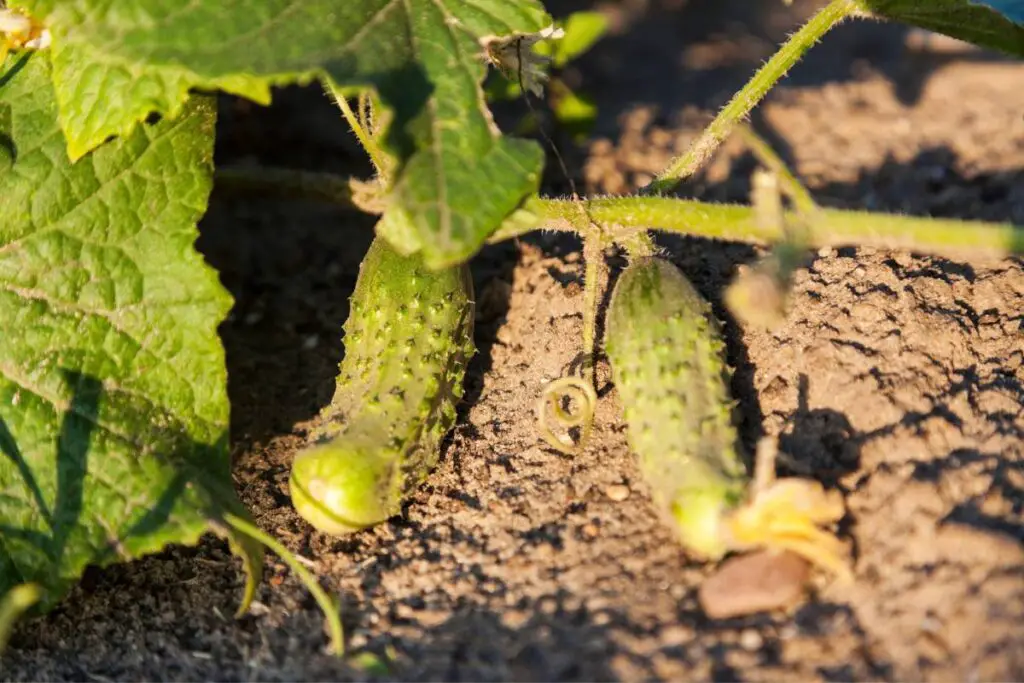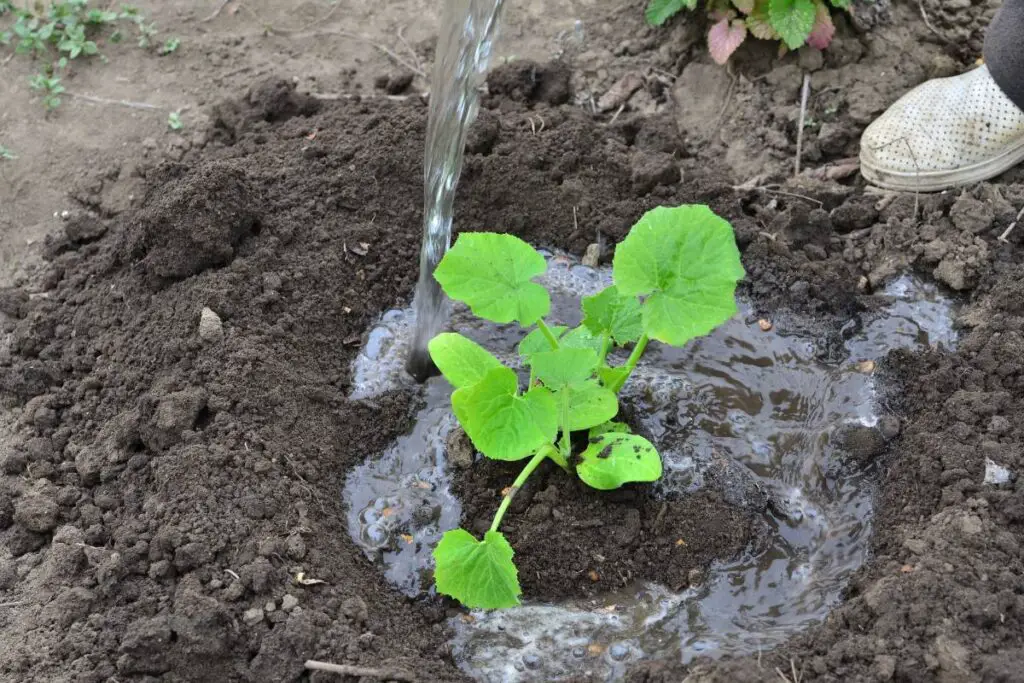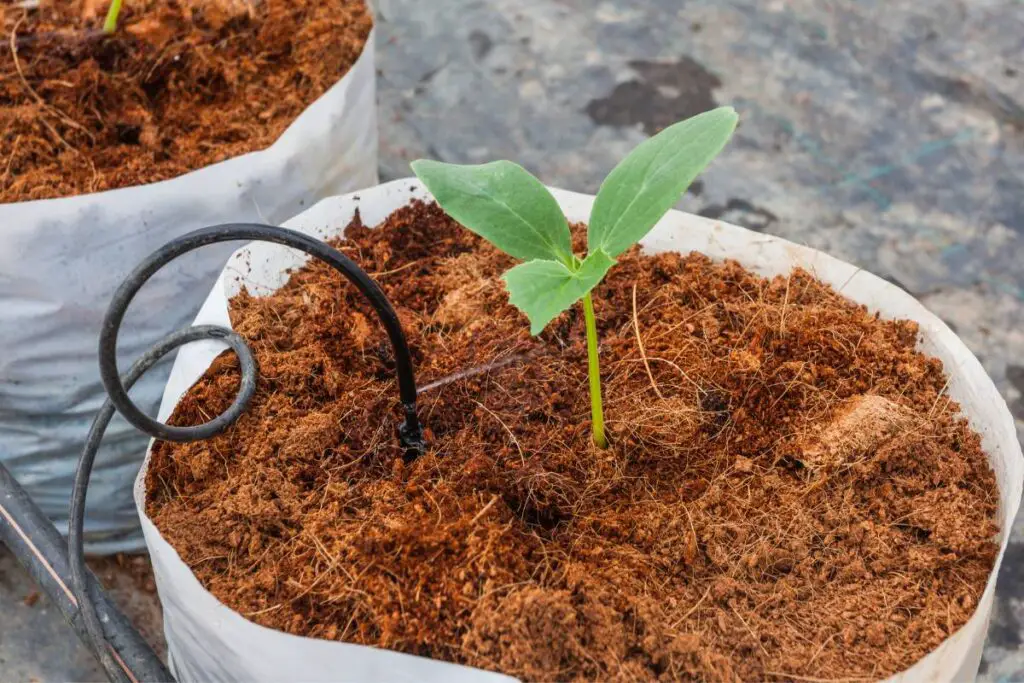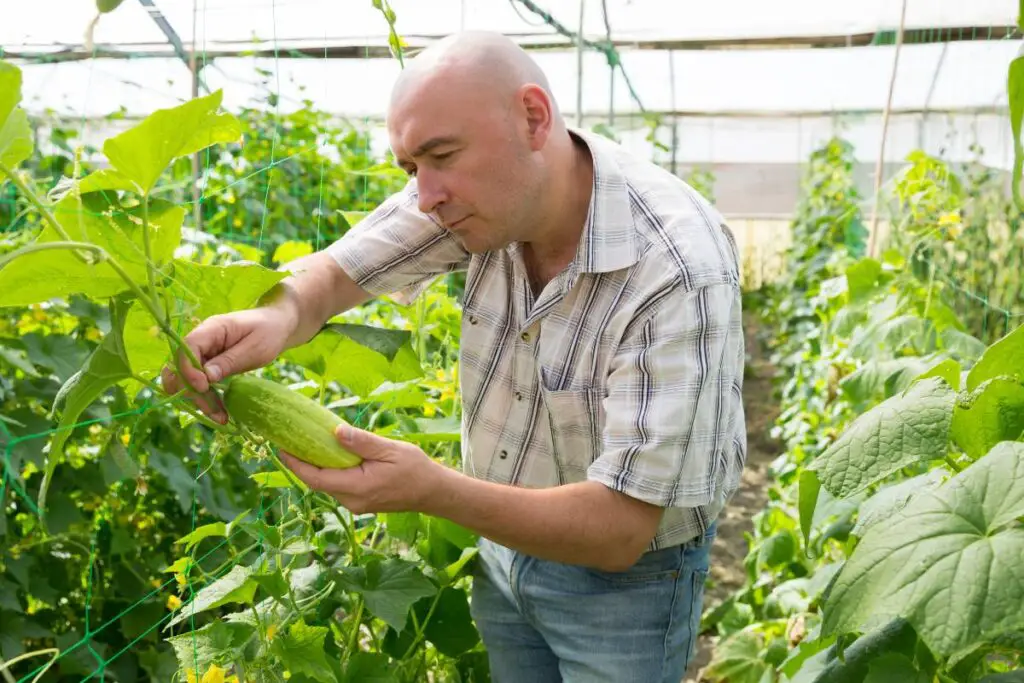Cucumbers are warm-weather lovers. So, hot weather should be fine for their growth and development. But there is a limit to tolerating the heat. So, this article is about the heat tolerance of the cucumbers.
Cucumber plants prefer temperatures between 70-85°F and can tolerate temperatures up to 90°F (32°C). However, temperatures above 90°F can cause the plants to stop growing, reduce yields, and become more susceptible to pests and diseases.
The cucumbers need warm temperatures and not heated temperatures. This article explains the ideal temperature for cucumbers, the highest temperature they can tolerate, the effects of extreme temperatures, how to protect the plants, and some heat-tolerant plants.

Optimal temperature range for cucumber plants
Cucumbers are summer plants because they love warm weather.
They develop the best when the temperature stays between 75°F to 85°F.
At the most, they will bear up to 90°F.
During the day, the best temperature of the cucumbers is 75°F to 85°F and 60°F at night time.
Since the cucumbers are warm weather lovers, they tolerate temperatures up to 90°F.
But once the temperature starts increasing after that, the plant will begin to suffer if not protected.
With this ideal temperature, the cucumbers will perform the best and develop fully within 50 to 70 days.
Effects and signs of heat stress on the cucumber plants
The ideal temperature for the cucumbers is between 75°F and 85°F.
The highest temperature cucumbers can tolerate is 90-95°F.
Once the temperature goes above 95 to 100°F, the plant will start suffering.
Below are some results of exposure to excessive heat in the cucumber plants:
Water stress
This is one of the most common effects in cucumbers during extreme weather conditions.
Despite following the correct watering routine, you will suddenly see the plant losing moisture faster than usual.
The high temperature increases the rate of evaporation and water loss through transpiration.
As a result, the plant loses moisture faster and suffers from underwatering.
Over time, this will lead to wilted and discolored leaves, weak plants, and less plumpy cucumbers.
Stunted growth
This effect is seen in both heat and cold stress.
Exposure to extreme temperatures, whether hot or cold, slows down the growth of cucumber. Over time, it will stop developing.
Excessive heat will reduce the function of photosynthesis and sufficient energy production.
This further results in short internodes and small leaves.
Fewer yields
Under excessive heat, the plant produces fewer cucumbers.
The heat stresses the flowers and, ultimately, falls off the plant without producing any fruits.
The high temperature will not allow proper pollination, even if there are flowers.
So, there will be relatively fewer yields than expected.
Increased pests
A lot of pests are attracted to dry conditions.
The plant will dry out if not watered well when the temperature is exceptionally high.
As a result, many pests and diseases will get attracted to your plant.
Powdery mildew gets attracted by hot and humid climates.
Once it affects your plant, it will reduce its growth, decrease yields, and damage its overall growth and development.
Distorted fruits
Excessive heat stress will lead to distorted cucumbers.
The fruit size will be shorter than usual, with a bulbous end, looking like a gourd.
Looking for gardening supplies? We have tested 100's of products before recommending them to you guys. Check out our best pick below:
| Image | Gardening Supplies | Best Price? |
|---|---|---|
 Top
Top Top
Top | Raised Garden Bed Kit | Check On Amazon |
 | XLUX Soil Moisture Meter, Plant Water Monitor, Soil Hygrometer Sensor for Gardening, Farming, Indoor and Outdoor Plants, No Batteries Required | No Results |
 Top
Top Top
Top | 82 Pcs Garden Tools Set and Extra Succulent Tools Set | Check On Amazon |
 | Joeys Garden Expandable Garden Hose with 8 Function Hose Nozzle, Lightweight Anti-Kink Flexible Garden Hoses, Extra Strength Fabric with Double Latex Core, (50 FT, Black) | No Results |
 Top
Top Top
Top | Dual Chamber Compost Tumbler | Check On Amazon |
 Top
Top Top
Top | Sunnyglade Plant Stakes | Check On Amazon |
 Top
Top Top
Top | Organic Cold Pressed Neem Seed Oil | Check On Amazon |
 Top
Top Top
Top | Mighty Mint Gallon :-Insect and Pest Control Peppermint Oil | Check On Amazon |
 Top
Top Top
Top | Scotts DiseaseEx Lawn Fungicide | Check On Amazon |
 Top
Top Top
Top | Jacks Classic 20-20-20 All Purpose Fertilizer | Check On Amazon |
 Top
Top Top
Top | 30,000 Seeds Pollinator Attracting Wildflower Mixture | Check On Amazon |
 Top
Top Top
Top | Survival Vegetable Seeds Garden Kit-Over 16,000 Seeds | Check On Amazon |
Signs of heat stress in the cucumber plants
To avoid these effects, you must identify the signs of heat stress and take immediate action to protect the plant from it.
Below are some common signs you will see when your plant is under heat stress:
- Wilted leaves – This is one of the common signs of heat stress. When the temperature rises, the plant will react by wilting and not standing tall. Another reason is water stress.
- Discolored leaves – Excessive heat leads to sunburns. You will often see the tips and edges of the leaves turning yellow and then progressing to browning.
- Curly leaves – The discolored part curls over time due to heat stress.
- Thin leaves – Due to the excessive heat, the leaves lose their turgidity and become thin.
- Flowers falling off – When the heat is too much for the plant to handle, the flowers will fall off. The heat disrupts pollination and fertilization, resulting in lower yields and under-developed fruits.
Watering cucumber plants in the hot weather

Watering the cucumber plants is one of the best ways to protect them from heat stress.
Watering them frequently during the hot summers will keep them hydrated and give the root system enough moisture to stay solid and unaffected by heat stress.
Constantly water the plants during the early morning or in the evening.
Keep the soil evenly moist.
Except for these times, if you need to water the plant because of the extreme temperatures, water the soil instead and avoid the leaves.
When sunlight and water droplets are on leaves, the intensity of the sunlight is magnified, causing sunburns.
So, avoid overhead watering.
A lot of gardeners follow a watering routine.
For example, some water them once or twice weekly with 1-2 inches.
But, I do not follow any such routine because nature is unpredictable.
Just because the weather is too hot, do not water too much and overwater it.
So, I always check the moisture level of the soil before watering.
If the top few inches have dried up, I apply enough water to the soil.
I water the plant early morning or evening when the heat is less than in the day or afternoon.
In between, I keep checking them 1-2 times and provide water during the scorching temperatures to keep them from heat stress.
Providing shade for the cucumber plants
Another way to protect the cucumber plants is by providing them with enough shade from the sunlight, especially when the temperatures are above 95 to 100°F.
Since the temperature is excessively high, shading the plants slightly from sunlight will reduce heat stress.
Here are some ways to shade the cucumber plants:
Umbrella shade cloth
Put up an umbrella shade cloth over the cucumber plants.
The cloth will protect the plants from the direct sun rays and reduce the temperature to around 10°F.
So, if the surrounding temperature is 90°F to 95°F, your plants will still have 85 to 90°F.
I use this shade during the hottest times of the summer months.
I also maintain proper moisture for my cucumber plants to keep them from heat stress.
The fabric of the cloth depends on how much protection you want to provide your plants.
Make sure that you don’t completely block the sunlight.
The rule is to reduce the heat stress and not the sunlight.
Shady structure
You can create a DIY structure to shade the cucumber plants, like an arbor or pergola.
If the sunlight is too intense to handle, these will give your cucumber at least partial sunlight during the hot summers.
However, there is one problem.
Since the pergola is a structure, keeping the cucumbers under throughout the year will not benefit them.
Cucumbers need 6 to 8 hours of direct sunlight.
So, these structures are suitable for potted plants.
You must remove the plants from the structure for adequate sunlight.
Mulching cucumber plants in the hot weather

Mulching is a great way to help your plants stay hydrated and protect them from heat stress.
Exposure to scorching weather will dry out the moisture and dehydrate the plant faster than usual.
Mulching the cucumbers will retain the moisture in the soil and prevent them from evaporating and drying out.
The plants will have enough moisture trapped in the soil and stay hydrated. You also can water the plant sparingly.
When the temperature is above 95°F or 100°F, apply 1 inch of thick mulch around the plant using dried leaves, straws, and shredded newspaper.
Over time, the mulch will break down and add necessary nutrients to the soil.
You can also add organic compost to your soil to improve moisture retention.
You do not have to water the plant too often.
Remove the mulch when the weather starts cooling down.
Fertilizing the cucumber plants in the hot weather
Fertilizing the cucumbers during the hot weather with excessively high temperatures is tricky.
If the plant is fine and you have been able to protect it from heat stress, you can continue fertilizing it as you are doing.
When the temperature rises above 90 to 95°F, the moisture evaporates from the soil. It further affects the availability of nutrients.
Excessive hot temperatures can dry up the roots of the plant, which disrupts the roots’ ability to absorb the nutrients from the soil.
As a result, the plant suffers from over-fertilization.
However, you cannot stop fertilizing, as that will lead to nutrient deficiency.
While fertilizing, ensure the plant receives all the nutrients while avoiding potential stress.
The plant can already get affected by heat stress.
Over that, it will be detrimental if it starts to get affected by over-fertilization.
Start fertilizing when the plant reaches a few inches tall or the flowers appear.
The fertilizers should be incorporated into the soil.
Water the plant very well after fertilizing.
Apply fertilizers when the temperature is cool, i.e., early morning or evening after the sun goes down.
For slow-release fertilizers, use them every month. For liquid fertilizers, use them every 2 weeks for 4 weeks.
Heat-tolerant cucumber varieties
If you are from warmer zones where the summers get too hot, and temperatures rise above 95 to 100°F, grow the heat-tolerant varieties.
Here is a list of some heat-tolerant varieties ideal for warmer zones with hot climates:
Olympic
These slicing cucumbers enjoy soil temperatures ranging between 75 and 95°F.
The cucumbers are firm, 10 inches long, and 2 feet tall.
Since these cultivars are hardy, you can grow them in regions with hot and moist climates.
It also has tolerance for the mosaic virus, downy and powdery mildew, and leaf spot.
A plus point about this variety is that the flowers can attract bees and butterflies.
Dasher II
Dasher II cultivars are dark green slicing cucumbers with a temperature tolerance of 75 to 85°F.
The cucumbers have a delicious flavor measuring about 8 inches long.
The variety is popular in hot weather conditions and is highly resistant to several cucumber diseases.
Thunder
Thunder cultivar is not only heat-resistant but also an early-maturing cucumber.
The cucumber reaches about 8 inches long at maturity and has a robust flavor.
The cultivar can tolerate heat stress and is resistant to downy and powdery mildew and scab.
Beit Alpha
The Beit Alpha cucumbers look like the seedless Dutch varieties.
The cultivar is parthenocarpic and does not need to pollinate to produce fruits.
It can tolerate temperatures up to 100°F, which is quite impressive.
These are ideal for pots as mature fruits grow only 1.5 inches in diameter.
Eureka
Eureka cucumbers are famous in zones 3 through 9.
So, they can tolerate hot temperatures around 90 to 95°F to some extent.
The variety works both for slicing and pickling.
Along with being heat-tolerant, the variety is a famous disease-resistant and fast maturing that prepares for harvest within 57 days.
Spacemaster
This cultivar is ideal for zones 3 through 14, which means it has excellent tolerance for heat.
These varieties would be ideal for zones where temperatures can rise to 90 to 95°F and sometimes 100°F.
However, you should still care for the plant and protect them from excessive heat.
Harvesting cucumbers in the hot weather

Harvesting the cucumbers in hot weather can be risky because there is already a risk of heat stress present.
It is more dangerous when the temperature crosses 95 to 100°F.
Usually, the right time to harvest the cucumbers is after 50 to 70 days of planting. You can understand this by touching the cucumbers.
The fruit will be bigger, juicier, and plumpy, have a rough and bumpy texture, and reach a mature size.
For the slicing varieties, the mature size is 6 to 9 inches or longer. For the pickling, it is within 2 to 4 inches.
But, if the harvesting time is too hot, you must be careful about the harvest.
The best time to harvest is in the early morning when the plant has dew drops and the stems are still cool.
The plant is already under heat stress. Proper protection can reduce stress, but you must be more careful. Harvesting in the early morning can reduce stress.
Leave ¼ inch to 1 inch of the stem in the plant, and cut the fruit.
Leaving this much space will prevent rotting and encourage new fruit.
Check the cucumbers and harvest them every other day during the on or off-peak season.
Planting time
If you are from hotter zones, the planting time of the cucumbers is something to consider.
The ideal season to plant the cucumbers is summer, and the right time is 2-3 weeks after the last spring frost.
But in a warmer zone where the summer temperatures reach 90-95°F during the hottest season, you won’t probably receive the frost.
So, you need to adjust the timing here.
The best temperature for the cucumbers is 75 to 85°F, and the best soil temperature is 65 to 75°F.
Whenever the soil temperature rises to 60-65°F, start planting the cucumbers. It is typically the spring or mid-spring season.
You can use a soil thermometer to check the accurate soil temperature for the cucumbers.
Soil preparation
Soil preparation for direct sowing or transplanting the seedling begins in the fall.
Dig the soil bed 25 to 30 cm deep and break all the soil lumps.
Add some organic matter to the soil and mix them well.
If the soil quality degrades again, dig it up one week before planting, break the lumps, remove weeds, and make 20-30 cm grooves to fill them with organic matter.
One day before planting, add some phosphates and potassium salts.
Keep 24 inches of distance between each seedling or seed.
Pest management
Even hot weather conditions can attract pests, especially when accompanied by high humidity.
Keep an eye on your cucumber plants and examine their conditions.
If you find signs like wilting, yellowing, or holes in the leaves, check for infestation.
If you spot any pests, shower the plant to dislodge the pests, and use neem oil or insecticidal soap to deter the pests.
Try planting some companions that can deter these pests, for example, dill, nasturtiums, marigolds, and sunflowers.
Take good care of your plant and avoid stress.
Final thoughts
Cucumbers enjoy warm weather and prefer temperatures between 75 to 85°F. But hot and high temperatures are not something they will enjoy. Once the temperature goes above 90°F to 95°F, the plant will start suffering. You will see signs of heat stress, like wilted or yellow leaves, curly leaves, fewer yields, fallen flowers, and dry soil.
When you see these signs despite taking proper care, it means the weather is too hot for the plant to handle. Ignoring will kill it. To protect the plant from heat stress, provide shade during the hottest days, water it more often, and a layer of mulch to keep it hydrated and prevent moisture evaporation.
Growing heat-tolerant cultivars like Olympic, Thunder, Beit Alpha, Dasher II, Eureka, and Spacemaster are better options. Harvesting the cucumbers during the hot day or afternoon is stressful for the plant. Picking them in the early morning when the weather is still cool will keep your plant from further stress.
Can cucumbers receive too much sunlight?
Cucumbers need at least 6-8 hours of sunlight. But if the sun’s intensity is too much and the temperature is high, it will stress the plant. So, protect your plant by shading, regular watering, and mulching.
How often should I water the cucumbers during the hotter months?
The ideal watering routine is 1 inch of water per week. Increase it according to the soil’s moisture level in hotter months, for example, 2-3 inches of water weekly. Check the soil before watering.
Reference: Cucumber Wikipedia
